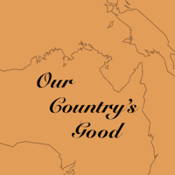
Overview
Synopsis
Inspired by the historical events surrounding the “first fleet” of British convicts sentenced to transportation to Australia in the 18th century, Our Country’s Good follows second lieutenant Ralph Clark as he decides to stage a play in order to rehabilitate the criminals who have arrived at the penal colony in New South Wales. Choosing the play 'The Recruiting Officer' by George Farquar, the ambitious Ralph forms up a motley cast of convicts, each with their own motivations for joining the play. Rehearsals are interrupted when an escape attempt lands half of the cast in prison, but the compassionate Governor Phillips advocates for the play to continue, believing that Ralph’s efforts can re-educate the convicts, no matter what their crimes. Set against the backdrop of the British colonization of Australia, Our Country’s Good explores themes of empathy, humanity and justice, and resolves with a message of hope and redemption for all of the convicts, and for Ralph himself.
Based on the novel 'The Playmaker' by Thomas Keneally, Our Country’s Good features many characters based on real historical figures from the time. The play is built for double-casting, and is commonly performed with 10 actors across the 22 parts.
Show Information
Context
Plot
Characters
| Name | Part Size | Gender | Vocal Part |
|---|---|---|---|
|
Lead |
Male |
Non-singer |
|
|
Supporting |
Male |
Non-singer |
|
|
Supporting |
Male |
Non-singer |
|
|
Supporting |
Female |
Non-singer |
|
|
Supporting |
Female |
Non-singer |
|
|
Featured |
Male |
Non-singer |
|
|
Featured |
Male |
Non-singer |
|
|
Featured |
Male |
Non-singer |
|
|
Featured |
Male |
Non-singer |
|
|
Featured |
Male |
Non-singer |
|
|
Featured |
Female |
Non-singer |
|
|
Featured |
Female |
Non-singer |
|
|
Featured |
Female |
Non-singer |
|
|
Featured |
Male |
Non-singer |
|
|
Featured |
Male |
Non-singer |
|
|
Featured |
Male |
Non-singer |
|
|
Featured |
Male |
Non-singer |
|
|
Featured |
Male |
Non-singer |
|
|
Featured |
Male |
Non-singer |
|
|
Featured |
Male |
Non-singer |
|
|
Featured |
Male |
Non-singer |
|
|
Featured |
Male |
Non-singer |
Songs
A song with an asterisk (*) before the title indicates a dance number; a character listed in a song with an asterisk (*) by the character's name indicates that the character exclusively serves as a dancer in this song, which is sung by other characters.
Monologues
Scenes
Key Terms
Sorry! We do not currently have terms for this guide.
Videos
Sorry! We do not currently have videos for this guide.
Quizzes
Themes, Symbols & Motifs
Sorry! We do not currently have learning modules for this guide.
Quote Analysis
Sorry! We do not currently have learning modules for this guide.
